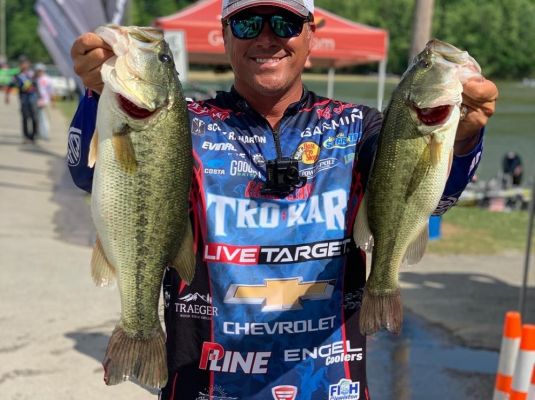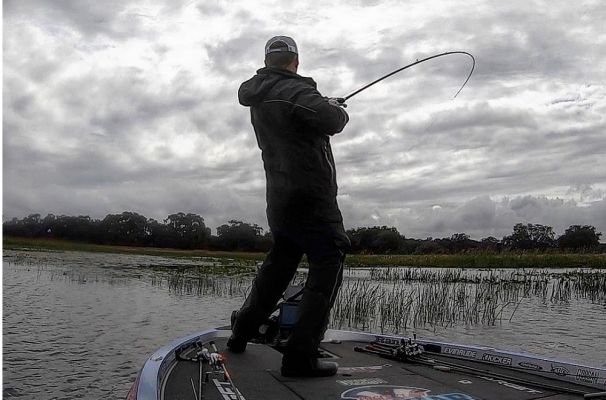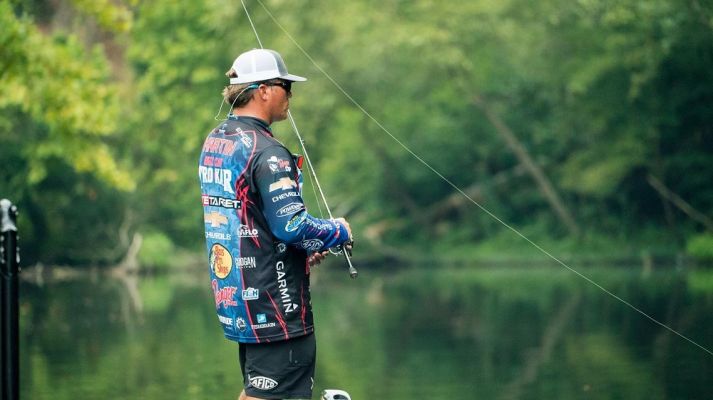Braided fishing line continues to grow in popularity. It is strong, great casting, and the quality keeps getting better. Another recent trend is the addition of multiple color options that help with specific techniques.
Professional angler Scott Martin is on the high-vis yellow bandwagon and keeps finding more uses for it. He shared the different ways that he uses P-Line’s popular TCB Teflon Coated Braided Line for this article.
High Vis Yellow Braid
This was the first year that Martin used a yellow braid exclusively on spinning gear, and he’s not going back, plus he has plans to start implementing it into select techniques on baitcast equipment.
“I use 10 and 15-pound yellow braid with an 8 to 12-pound P-Line Tactical Fluorocarbon leader on my spinning reels almost all of the time because there are so many benefits. Obviously, you can see it better, and that is important to me,” he said. “I am a ‘line watcher,’ and for Ned Rigs and light drop-shot rigs it has been great to see all of the bites as the bait falls. In the past, you might still feel some of those bites, but you'd be surprised by it and not always get a good hookset.”
He also feels that it has an application for flipping and punching as well as swim jigs and topwaters. “If your eyesight isn’t that great, there is no reason why you couldn’t flip and punch with it. Just use a marker for six or eight feet of the line, and you can see those light bites,” said Martin.
He said with fast-moving techniques like topwater and swim jigs; it might not even matter what color the line is. “I don’t think the fish are watching the line and if the cover is thick, they probably can’t even see what color the line is,” Martin shared. “The more I use yellow, the more ideas I have for times to use it because it is so helpful to see your line during your retrieve. If you can see your line, there is no second-guessing if you get a bite.”
Low Vis Green Braid
The low visibility of the green braided line is something that Martin relies on for a variety of techniques. Flipping, pitching, punching, frogs, and topwater lures are times when he reaches for the standard Green P-Line TCB 8 braid.
“I use 65-pound a lot for punching and flipping. For frogs and topwaters I like 50-pound because it casts so great,” he said. “If I am using a walking topwater bait, I’ll add a short six-inch leader of 17 or 20-pound P-Line CXX.”
8 Strand vs. 4 Strand
Besides just different colors of braid, the number of strands is another thing to consider. The 8-strand braids are thinner and smoother, and this is what Martin uses for bass fishing.
“The TCB 8 is very smooth, and it has a light Teflon coating which makes it a little stiffer, but it cuts down on wind knots and other problems you get with uncoated braids. It is also really quiet and durable, which are both very important to me,” said the Florida pro.
Knot and Leader Thoughts
Fishermen are continually talking knots and comparing what they use. There are plenty to choose from when it comes to combining braid to fluorocarbon, but Martin sticks with the tried and true Double Uni.
“I’ve never had any problems with it, and it is a great knot if you tie it right. For my leader length, I keep it pretty simple and use six to eight feet of fluorocarbon for my spinning setups,” said Martin.
A Common Braided Line Mistake
As one of the most popular professional anglers with hordes of social media followers and YouTube subscribers, Martin is subject to plenty of questions from anglers. He said one mistake stands out and keeps coming up.
“I hear it all the time where people have trouble with braid, and it almost always comes down to the pound test they are using. The 20-pound test may seem strong, but it is way too thin for baitcast reels,” he shares. “My rule of thumb is never to put less than 40-pound on baitcasting and to never go above 30-pound on spinning reels.”
When it comes to braided fishing line, Scott Martin and countless other bass anglers have come to love the benefits of a high visibility line. But, having another option in low visibility green is a way to cover all of your bases. Braided line is a must for bass fishing and knowing when to use the right color line can significantly increase your odds of catching more bass.






 Advertising
Advertising